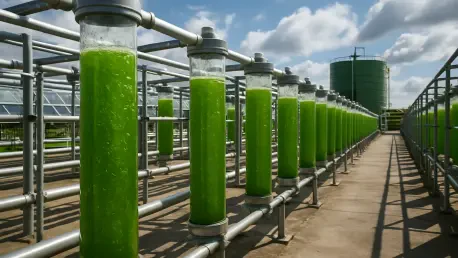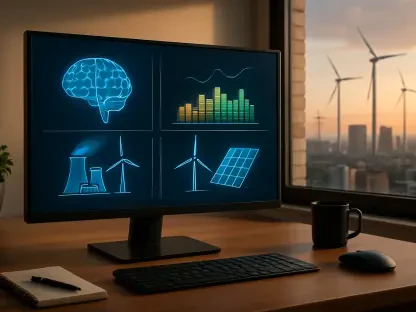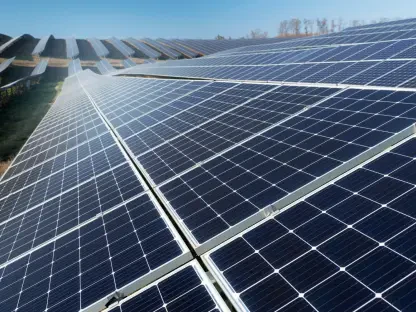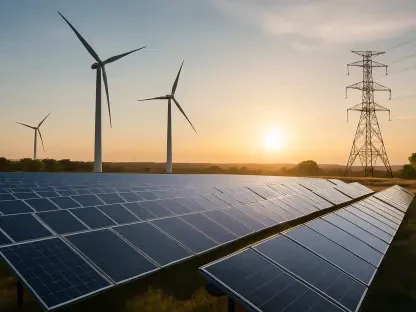As the world grapples with escalating energy demands and the pressing need to combat climate change, a quiet revolution is brewing in the realm of renewable resources through the remarkable potential of microalgae. These microscopic photosynthetic organisms are capturing attention for their ability to address global energy challenges while offering a sustainable alternative to traditional bioenergy sources. Unlike conventional crops such as corn or sugarcane, microalgae require minimal land and water, thriving in environments unfit for agriculture, thus avoiding competition with food production. Their rapid growth rates and capacity to produce a diverse array of valuable products position them as a transformative force in the quest for greener solutions. This article delves into the unique advantages of microalgae, exploring their environmental benefits, biorefinery potential, cultivation methods, and the hurdles that must be overcome to unlock their full promise in shaping a sustainable energy landscape.
Surpassing Conventional Bioenergy Sources
Microalgae are increasingly recognized as a formidable alternative to traditional biofuel feedstocks due to their exceptional efficiency and adaptability. These tiny organisms can double their biomass in mere days, enabling frequent harvests and significantly higher yields compared to crops that take months to mature. Their ability to grow in non-arable settings, such as saltwater or wastewater, eliminates the strain on agricultural land and freshwater resources, a critical concern in a world facing food security challenges. This resource efficiency not only makes microalgae a viable option for large-scale bioenergy production but also ensures that energy generation does not come at the expense of vital food systems, presenting a balanced approach to meeting global demands.
Furthermore, the scalability of microalgae offers a distinct edge over conventional sources in addressing future energy needs. Their minimal dependency on fertile soil and extensive irrigation systems means that production can be expanded without encroaching on farmland or disrupting ecosystems. Research continues to highlight how these organisms can be cultivated in diverse climates and conditions, from coastal regions to industrial waste zones, maximizing their potential as a universal energy solution. This adaptability underscores why microalgae are seen as a cornerstone for sustainable bioenergy, capable of supporting a growing population without compromising environmental or agricultural priorities.
A Dual Role in Environmental Sustainability
One of the most compelling attributes of microalgae lies in their profound environmental benefits, particularly in mitigating climate change. Through photosynthesis, these organisms absorb substantial amounts of carbon dioxide, acting as a natural mechanism to reduce greenhouse gas levels in the atmosphere. This carbon sequestration capability is especially crucial at a time when global temperatures are rising, offering a tangible way to offset emissions from industrial and urban activities. By integrating microalgae cultivation near emission-heavy facilities, it becomes possible to capture CO₂ directly, transforming a pollutant into a resource for biomass production.
Beyond carbon capture, microalgae demonstrate remarkable potential in pollution remediation, further enhancing their environmental value. They can utilize nutrients from municipal or industrial wastewater, effectively cleansing contaminated water while generating valuable biomass for energy and other uses. This process not only tackles water pollution but also aligns with the principles of a circular economy, where waste is repurposed into economic assets. Such dual functionality positions microalgae as a powerful tool for addressing multiple ecological challenges simultaneously, making them indispensable in the pursuit of a cleaner, more sustainable planet.
Diverse Outputs Through Biorefinery Applications
Microalgae extend far beyond their role in bioenergy, emerging as a versatile resource for a wide range of high-value products. In addition to producing biofuels such as biodiesel and bioethanol, they yield compounds like omega-3 fatty acids, antioxidants, and natural pigments, which are highly sought after in industries spanning pharmaceuticals, cosmetics, and food production. This multi-product capability sets microalgae apart from traditional biomass sources that often focus on a single output, creating diverse revenue streams that enhance the economic feasibility of their cultivation.
The biorefinery potential of microalgae also lies in their ability to cater to niche markets while supporting broader energy goals. For instance, the extraction of specialized biochemicals can offset the costs of biofuel production, making the entire process more financially sustainable. As industries increasingly seek eco-friendly ingredients and materials, the demand for microalgal byproducts continues to grow, driving innovation in processing techniques to maximize output diversity. This versatility not only strengthens the case for investment in microalgal technologies but also highlights their role as a transformative resource in building a sustainable industrial ecosystem.
Navigating Cultivation and Processing Techniques
The success of microalgae as a bioenergy source heavily depends on the methods used for their cultivation and conversion into usable products. Open pond systems stand out for their cost-effectiveness and simplicity, making them an attractive option for large-scale operations. However, these systems are vulnerable to contamination and environmental fluctuations, which can impact yield consistency. Despite these drawbacks, ongoing advancements aim to improve resilience and productivity in open systems, ensuring they remain a practical choice for widespread adoption in various regions.
In contrast, closed photobioreactors offer greater control over growth conditions, resulting in higher biomass yields and quality, albeit at a steeper cost. These systems are particularly suited for producing high-value compounds where precision is paramount, though their expense limits scalability for bulk bioenergy production. Meanwhile, conversion processes like anaerobic digestion and fermentation are critical for transforming biomass into biofuels, with research focused on enhancing efficiency and reducing operational costs. Balancing these approaches is essential to make microalgal technologies commercially viable, paving the way for broader integration into energy markets.
Overcoming Barriers to Widespread Adoption
Despite their immense potential, microalgae face significant obstacles that must be addressed to achieve mainstream status as a bioenergy source. The high costs associated with harvesting and processing remain a primary concern, often outweighing the benefits of their resource efficiency in the short term. These financial barriers are compounded by the logistical complexities of scaling production to meet industrial demands, requiring substantial infrastructure investments that can deter stakeholders from committing to large-scale projects.
Additionally, the technical challenges of maintaining consistent output on a commercial scale cannot be overlooked. Variations in microalgal species, environmental conditions, and biochemical composition affect the efficiency of conversion processes, necessitating tailored solutions for different applications. Overcoming these hurdles demands sustained innovation in cost-effective harvesting techniques and robust system designs. Supportive policies and funding for research are also crucial to bridge the gap between laboratory achievements and real-world implementation, ensuring that microalgae can fulfill their promise as a sustainable energy solution.
Building a Sustainable Energy Future
Looking ahead, the trajectory of microalgae in bioenergy production hinges on collaborative efforts and technological progress to surmount existing challenges. Optimizing cultivation systems, whether through cost-efficient open ponds or high-yield photobioreactors, remains a priority for enhancing productivity and economic viability. Advances in genetic engineering and bioprocessing hold immense potential to boost biomass yields and expand the range of usable byproducts, making microalgae a more attractive investment for industries seeking sustainable alternatives.
Equally important is the role of strategic partnerships among researchers, industry leaders, and policymakers to integrate microalgae into existing energy and agricultural frameworks. Developing incentives for adoption and creating regulatory support can accelerate the transition to commercial-scale operations. By focusing on these actionable steps, the path forward becomes clearer, enabling microalgae to reshape resource management and contribute to a renewable, waste-free economy. This collective push offers hope for a future where energy needs align seamlessly with environmental stewardship.









